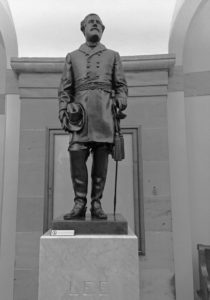 Virginians woke up Monday morning, December 21, 2020, to the news that the statue of Robert E. Lee was removed overnight from statuary hall of the U.S. Capitol. The Lee statue had stood in the hall as one of Virginia’s two designated representative statues for 111 years. Each state is allowed two statues, some of which are in statuary hall while others are located in other areas of the Capitol building. The second Virginia representative is George Washington.
Virginians woke up Monday morning, December 21, 2020, to the news that the statue of Robert E. Lee was removed overnight from statuary hall of the U.S. Capitol. The Lee statue had stood in the hall as one of Virginia’s two designated representative statues for 111 years. Each state is allowed two statues, some of which are in statuary hall while others are located in other areas of the Capitol building. The second Virginia representative is George Washington.
So why was Robert E. Lee removed?
I’ve been addressing the issue of Confederate statues and other monuments to the Confederacy in a series of posts beginning with “The Rational Case for Removing Confederate Monuments.” Two subsequent posts (to date) looked at whether such removal “erases history” and whether “added context” was possible. Those posts provide some needed background for evaluating the current action.
In short, many jurisdictions – states, localities, federal – have been reassessing the message put forward by honoring Confederate leadership such as Lee and Jefferson Davis. Several statues have been removed, most notably statues in New Orleans (Lee, Beauregard) and Charleston, South Carolina (John C. Calhoun). A handful of statues were pulled down by mobs during this past summer’s protests following the death of George Floyd and others. Similarly, a few schools have been renamed (Robert E. Lee High School in Virginia is now Barack Obama High School). The Defense Department has indicated it will rename army bases currently named after Confederate generals. Overall, however, the vast majority of statues and names remain in place, some perhaps forever while others while public discussion continues.
Speaker of the House Nancy Pelosi in 2020 ordered the movement of several portraits of prior Speakers who had, after serving as leader of the House of Representatives, then rejected their U.S. citizenship to become leaders in the Confederacy. These portraits remain in the Capitol but now are found in less prominent locations, in essence reflecting their downfall from grace. The current decision by the state of Virginia to remove Robert E. Lee follows in this general reassessment of Confederate iconography. The moves are not restricted to Democratic leaders; Republican Governor Ron DeSantis spearheaded the effort to replace Florida’s statue of Confederate General Edmund Kirby Smith with black civil rights activist and educator, Mary McLeod Bethune. Bethune also has a large statue in Lincoln Park, where the summer of 2020 saw efforts to save a statue of Lincoln and freedman Archer Alexander from destruction.
Other statues in statuary hall have been replaced for a variety of reasons by their sponsoring states. Ohio recently replaced a statue of former Governor William Allen with famed inventor Thomas Edison. In 2019, Nebraska replaced its statue of William Jennings Bryan with Ponca Chief Standing Bear. Ohio replaced James Harlan with agricultural scientist Norman Borlaug. In 2009, California replaced Thomas Starr King with former Governor and President Ronald Reagan. At least eight states have made recent replacements, seven have replacements pending, and three have replacements under consideration. Some of these are to replace Confederate statues, but most are for other reasons. Reevaluation of which icons of history each state wants to represent them are not unusual.
Which gets us back to Robert E. Lee. As a former Confederate state and location of the capital of the Confederacy, Virginia has had to assess and reevaluate its place in modern America. A statue of Jefferson Davis on Monument Avenue in Richmond was torn down by vandals during the George Floyd protests. A large equestrian statue of “Stonewall” Jackson was removed by the state. The removal of the Lee statue from statuary hall is a continuation of this reassessment.
The likely replacement of Lee is civil rights activist Barbara Johns, who in 1951, at the age of 16, led a walkout at her segregated high school to protest substandard conditions. Her lawsuit against the county was folded into the landmark Brown v Board of Education case resulting in the Supreme Court decision declaring “separate but equal” unconstitutional. Johns would be the only teenager represented in statuary hall. The Commission for Historical Statues approved the Johns statue and the Virginia legislature is expected to agree, after which a sculptor will be commissioned.
As states, local communities, and in some cases, federal actors continue to reassess the historical record, we are likely to see an increased effort for more inclusive representation in public spaces. Each of us can play a role by communicating our views to lawmakers at all levels of government. Meanwhile, I will continue to examine the issues associated with Confederate monuments in future posts. I’ll also take a look at “overflow” of the Confederate monument debate into other potentially controversial figures such as Christopher Columbus, our slaveholding founding fathers, and remarkably, even Abraham Lincoln.
David J. Kent is an avid traveler, scientist, and Abraham Lincoln historian. He is the author of Lincoln: The Man Who Saved America, Tesla: The Wizard of Electricity and Edison: The Inventor of the Modern World as well as two specialty e-books: Nikola Tesla: Renewable Energy Ahead of Its Time and Abraham Lincoln and Nikola Tesla: Connected by Fate.
Check out my Goodreads author page. While you’re at it, “Like” my Facebook author page for more updates!
[Photo Credit: Glynn Wilson, Why is Robert E. Lee’s Statue in the U.S. Capitol Not Yet the Subject of Controversy? | New American Journal]










